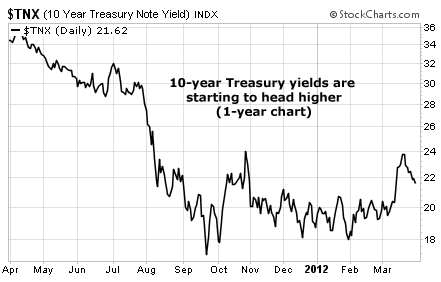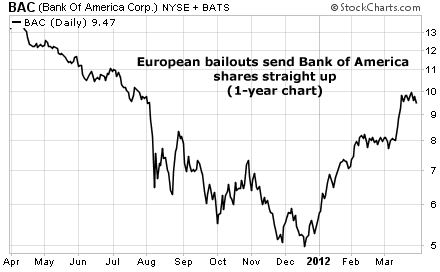 I admit, not every essay I’ve ever written has been useful. And because God does not whisper in my ear, more than a few of my ideas have been flat wrong. So be forewarned: I might be wrong about what follows below. But I can tell you this… I can’t recall a better, more powerful, or more likely way to make a lot of money…
I admit, not every essay I’ve ever written has been useful. And because God does not whisper in my ear, more than a few of my ideas have been flat wrong. So be forewarned: I might be wrong about what follows below. But I can tell you this… I can’t recall a better, more powerful, or more likely way to make a lot of money…
What I’m writing about today is probably the single best way for you to profit from the financial shenanigans our pathetic political leaders have foisted on us. There are logical and inevitable outcomes from their unrelenting money printing and the Fed’s ongoing manipulation of interest rates. I’ve been writing about these coming problems consistently since 2008. Many of you have profited from my earlier warnings about sovereign debt markets as well as the rise of precious metals and farmland.
[ad#Google Adsense 336×280-IA]I hope you will study today’s essay very closely… because the strategy I’ll show you below is far, far more powerful than any of the others we’ve used so far.
And… there’s something else, too.
If you follow the steps I outline below, you can strike back – directly – at the people who are most responsible for our ongoing financial calamity.
You can position yourself to profit from the inflation they’ve caused – using the same instruments they created in secret and are hoping you’ll never learn about.
But you must overcome one big hurdle…
For you to capitalize on this idea, you have to understand quite a bit about how our system of paper money works and what’s going to happen as it begins to fall apart. I fear some of you will find this explanation too complex… or that you’ll assume (falsely) that you can’t make these trades.
Believe me… even though some of these words might not be familiar… the strategy I’m going to outline today is one of the simplest ways of making money and is as old as paper money itself. Please read this carefully.
And please… don’t forward or share these ideas with anyone else. Keep this one for yourself.
Here’s the core idea: As the value of the U.S. dollar begins to fall substantially, other things – assets of all types – will begin to cost more and more. The government will label the resulting monetary chaos “inflation.” It will accuse people of “hoarding” and it will most likely begin to impose wage and price controls. These events are nearly inevitable, given the huge amount of monetary stimulus we’ve seen since 2008. Although these things haven’t happened yet… they will. It is only a matter of time now that the European Central Bank (ECB) has switched gears in late December and began printing enormous quantities of new money.
But… before we reach the coming dark days of rapidly rising prices and a collapse of the paper money system… we will see a huge appreciation in the share prices of our big banks. That might seem illogical… or even heretical. But that’s exactly what will happen because of the Federal Reserve’s public commitment to hold short-term interest rates down.
Let me explain… All banks earn a profit by borrowing money at low rates for short durations and then lending at higher rates for longer periods. This is the “lending spread” – the difference between long-term rates and short-term rates. The size of this spread, plus the amount of leverage banks use, determines how profitable they are.
As inflation begins to heat up, interest rates on longer duration bonds are going to rapidly increase. Inflation is extremely detrimental to the real value of long-term bonds. That’s why I’ve recommended selling short long-duration U.S. bonds via the TLT exchange-traded fund.
Long-term bond yields have been declining in the U.S. since the early 1980s. Most investors seem to think long-term interest rates will never increase again… but I believe the exact opposite. I believe the coming bear market in long-dated U.S. Treasury bonds will see bond prices fall and yields on long-dated bonds soar. It will be a true financial calamity – because the world’s entire financial system depends on the U.S. Treasury market as a source of banking reserves, loan collateral, and an interest-rate benchmark.
The U.S. 10-year bond yield is the “benchmark” yield for the entire world’s economy. The rate has been declining for 30 years. But now, after breaking through levels even lower than during the crisis of 2008, the yield on these bonds has begun to rise.
The chart below shows you the 10-year yield on U.S. Treasury bonds…

Quite simply, I think the markets now believe that both of the world’s leading economic zones (the U.S. and the European Union) are committed to bail out the world’s banks by creating unlimited amounts of new money and credit. As a result, we will see a huge spike in inflation and a corresponding increase in long-term sovereign bond yields, as investors flee long-term bonds in search of protection against inflation.
You might expect this would be bad for our biggest banks… and eventually, it probably will be. But that’s far down the road. What matters now is that the Federal Reserve has promised to hold short-term interest rates at close to zero. That is, the cost that banks must pay to borrow will be held near zero, while the rate they earn (the long-term rate) is going to soar.
You can think of it this way… Imagine you’re a retail baker (instead of a banker). The government decrees that your raw material costs (wheat, eggs, etc.) shall be fixed for the next two years… while the retail price of bread soars because of inflation.
It’s not hard to see the support these policies create for bank stocks. Just look at Bank of America. It was in a straight nosedive all last year as long-term rates fell, thanks to fears about whether the ECB would bail out Europe. Then late in the year, as it became clear that the ECB would print whatever funds were needed to save banks like UniCredit, the share price of Bank of America began to go straight up, almost every day. This is one of the most important indications that we’re heading for higher inflation and higher interest rates.

You must understand that there’s a flipside to the collapsing value of the U.S. dollar – rising asset prices. Thus, one of the best ways to protect yourself from a collapse in the exchange value of the U.S. dollar is to buy huge amounts of assets at heavily discounted prices – especially if you can find a way to add leverage to the mix. Bank of America holds $2.1 trillion in assets on its balance sheet – with only $152 billion of tangible equity. That’s leverage of 14-to-1. The coming inflation will make the value of these assets (things like mortgages) go up. Meanwhile, as interest rates rise, every new loan the bank makes will begin to pay a higher rate. But these higher rates won’t hurt the bank at all because the Fed will not allow the rates it pays to increase.
Do you see how this is a recipe for a huge increase in share price? Meanwhile, Bank of America still trades at less than half of book value. With all the big banks now free to increase their dividends, this wide discount from book value is going to be eliminated. Bank of America’s (BAC) shares are going to soar.
Now, let’s address something I know will be said about today’s essay. A large number of financial writers will criticize what I’ve written here today. They will say, “See… Stansberry is just a huckster. He doesn’t believe in the End of America. He’s recommending a bank stock, for Pete’s sake.”
Yes, that’s right. I am. Bank stocks can do very, very well at the beginning of a currency crisis – if the financial authorities protect them from rising interest rates. I can recall, for example, one of the first big booms I covered. It was the banking sector in Venezuela during the summer of 1996. Most of the stocks we recommended in Latin American Index (the first financial publication I worked for) were the top-gaining stocks for the entire year, in the entire world. The government’s manipulation of the currency and the resulting manipulation of interest rates allowed these banks to earn windfall profits.
The same thing will soon happen here… And Bank of America will be a primary beneficiary – at least until 2014. (That’s as far out as the Federal Reserve has promised to hold down rates.) But that gives us plenty of time to make a big profit. And we should… because these profits are all being generated at the expense of our currency.
There’s an unwritten law in the newsletter world that writers (and their publishers) ought to be either bullish or bearish. The reason is simple: Most people are either bullish or bearish. Most of you, dear subscribers, either see the world as a glass half-full or a glass half-empty. And you always will. You’ll gravitate toward those writers who support your viewpoint. And if we switch gears on you… most of our subscribers will cancel (or not renew). While this might not be true about you… I assure you it is absolutely true about our audience as a whole. That’s why most publishers stick to either an all-bearish or all-bullish view.
Our approach – telling you what’s most likely to happen, whether it’s perceived as bullish or bearish – tends to result in a huge amount of refunds. The other thing that will certainly happen is that my competitors will have a field day with the apparent contradictions in the advice I’m offering today.
The fact is, there’s no contradiction at all. Remember: the flipside to a collapse in the value of our dollar will be a rise in asset prices. And banks are the best way to see that this is actually happening. Their sharply rising share prices aren’t a sign of a healthy economy, they’re a sign of a massive inflation.
Regards,
Porter Stansberry
P.S. If you need more confirmation… you might find it interesting to know my colleague Dr. Steve Sjuggerud agrees with my outlook that bank stocks are almost certainly going to go way up over the next several months. And he’s found an even better – though slightly riskier – way for you to profit from this situation. As he wrote in a recent True Wealth Systemsnewsletter, huge gains are likely: “793% is our ‘base case.’ And returns of 1,233% are possible if things simply go back to normal…”
What Steve found is truly unique. I can literally guarantee you haven’t heard about this opportunity anywhere else – because the government created it so the government itself could make a huge amount of money during the inflation it’s going to create. That’s why I love Steve’s approach: It takes a tool the government created to enrich a few insiders and uses it to benefit our subscribers.
I can’t give away the details – that wouldn’t be fair to Steve, who discovered all of this stuff – or to his subscribers, who have paid for the research. But I strongly urge you to check out Steve’s report on the situation. You can learn about his True Wealth Systems service (and find out how to access this recommendation) here…
Source: The Growth Stock Wire


